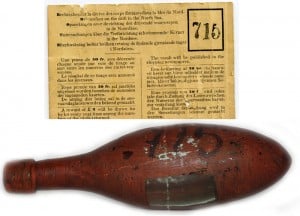Business of Doing Business: Show Me the Stuff You Hate – The Journal of Antiques and Collectibles – August 2012
By Ed Welch

The picture is of a message in a bottle. In the 18th and 19th centuries communications was slow. If a ship sank in the North Atlantic, it could take weeks for that fact to become known. England conducted current flow tests by throwing bottles overboard and recording locations at which the bottles were found. Each bottle and message had a unique number.
Current flow charts helped rescuers’ search in the most likely places. Antique current flow bottles are rare and no one knows how to price them. Would you pay $50 for one, $500, or perhaps two or three thousand dollars? It is a mistake to buy items of unknown value. If you do not know low selling price, high selling price and turnaround time, do not waste your buying money on a whim.
In the 1960s and early 70s I was a picker. At that time most pickers worked in pairs. I teamed up with one of three other dealers to go on picks. One of my partners, I will call him Jerry, had an unusual style of picking. Not long after we pounded on a door and was talking to a prospective seller, he would state boldly and loudly, “Show me the stuff you hate. I want to see tables with three legs, chairs with no seats, storm doors with broken glass, motors that do not run, paintings with holes through them, bicycles with broken wheels, crocks with no covers, stoneware with chips, rusted tools, an ax with no handle, and anything else that you want to get rid of. I will give you money for the stuff you hate and haul it away.”
When Jerry and I pounded on doors for a living, we had an established procedure to follow that ensured success. We had the most success picking small towns and rural villages with a population less than10,000 people.
Once a town had been selected, we would try to learn as much about the town and its history as possible. We visited the local library to see if any local histories had been written. We talked to the local historian, every small town has one. If the town had a Police Department, we would talk to the chief and anyone else associated with the department. Most small towns have a volunteer fire department. We would talk to as many fire fighters as we could find. We would talk to the selectmen, the town clerk, and the town treasurer.
We wanted everyone in a position of authority to know that we would be going door to door canvassing the town looking for things to buy. We knew that once we began pounding on doors homeowners would call one another, the town clerk, or the chief of police to check us out. Our goal was to pound on the door of every house in town. This could take several weeks and possibly several months.
Jerry and I worked as a team. While one of us was busy buying the junk, the other was talking to the wife about the possibility of buying high quality items and authentic antiques at higher prices. Before we finished buying from a home we wanted to be able to see all rooms, the attic, the cellar, and all out buildings. We wanted to make sure that we had at least looked at all the items we could possibly make money buying.
I know several pickers who still use this system today. Keep in mind that canvassing today often requires permits and a background check. Many towns limit canvassing hours, or prohibit canvassing entirely. Still, pounding on doors is a great way to buy antiques and collectibles.
Today, 35 to 40 years after canvassing a small town, I sometimes drive through that town. As I pass certain homes, I wonder if the grandfather clock still sets in the ell, if the ship’s painting by Badger still hangs above the mantle, and if the crock with the bird decoration is still used to put up salt pork for the winter.
Two years ago on a rural road in Downeast, Maine I drove by a home that once had 38 embossed Shaker bottles displayed on the living room mantle. I turned around and stopped at the home to see if the bottles were still on the mantle and if they could possibly be for sale.
The young lady who answered the door told me that she was the granddaughter of the woman who once owned the bottles. When she inherited the house, she put the bottles away in the attic and replaced them with more colorful bottles. She took me into her living room to look at her new bottles while she went to the attic to retrieve her grandmother’s bottles.
Her new collection of bottles consisted of reproduction cobalt blue plates, cups and saucers, glassware, several milk of magnesia bottles, and other recently made blue bottles.
She returned with her grandmother’s bottle collection. All 38 bottles were still in excellent condition and they were for sale. I made an offer of $500 for the collection, the same amount that I had offered her grandmother more than 35 years ago. Remember, the value of Shaker items has fallen in the past ten years.
The young lady was surprised and shocked by my offer. She believed that the bottles were worth less than $50. She decided not to sell the bottles to me because of my offer of $500. She told me that if I was willing to pay $500 then the bottles must be worth much more than this amount. She wanted time to find out the true value of the bottles before selling them to anyone.
I still pound on doors to this day. The major difference between then and now is that today I pound on the doors of homes to which I have been invited. Most of my invitations come through the Internet. A few invitations come from people I meet at large shows such as Brimfield.
I tend to buy less junk today because of the high cost of disposal. In the old days, I would often buy and haul away trash to gain favor with the home owner. Local dumps were open to the public and there were no disposal fees.
I would like to say a word or two regarding things considered valuable and things considered trash. To the grandmother, Shaker bottles were valuable and worthy of collecting. To the granddaughter, colorful blue glassware has more collecting appeal.
I try not to judge the younger generation for what many would consider a lack of good taste. Instead, when I pick a home or business I look for smaller glitzy items that appeal to the young collector. I place such items in a local auction. These items always sell but at a very low price. Still, because I did not pay much to buy them, I make a profit.
The television show, “American Pickers,” gives some idea of the process of picking antiques. Even though I like this show and watch it often, the show is far from complete and is not accurate.
The TV pickers drive an oversize box van from New England to Texas taking back roads looking for piles of stuff in back yards. The box van most likely gets 15 miles per gallon. The show does not give information on miles traveled, nights spent in motels, and the cost of meals. In my opinion, spending days wandering back roads hoping to spot a likely buying opportunity is a costly ineffective method of picking.
When the dealers do make a purchase, the quality of the product is low, the mark up too small to cover buying expenses and allow for enough profit to pay the wages of the three dealers on the show.
I have been a picker more than 40 years. I employ two full time workers, (one takes and processes 50 pictures a day, the other builds web pages), my wife is the office manager and handles business finances, I am the buyer.
When I make a buying trip, I must return with enough merchandise that will sell fast enough and for enough money to cover buying expenses, pay my employees, pay myself and my wife, pay ongoing overhead, and have enough money left over to pay for the next buying trip.
I will not leave on a buying trip unless I have several scheduled house calls, can take a route that allows me to shop one or two large outdoor shows, and shape that route to allow visits to many antique malls.





Related posts: